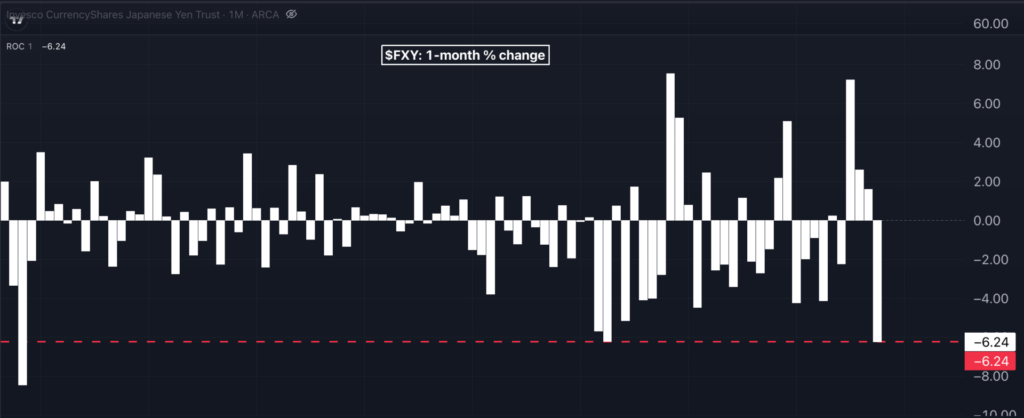Zinger Key Points
- The yen weakened to 153.20 per dollar after Japan's ruling coalition lost its majority, raising political and policy uncertainty.
- The yen is down 6.2% in October; further losses would mark its worst monthly performance since November 2016.
- Feel unsure about the market’s next move? Copy trade alerts from Matt Maley—a Wall Street veteran who consistently finds profits in volatile markets. Claim your 7-day free trial now.
The Japanese Yen, as tracked by the Invesco CurrencyShares Japanese Yen Trust FXY, weakened past 153.20 per U.S. dollar on Monday, marking its lowest level since late July 2024.
The decline follows a significant political shakeup over the weekend, as Japan’s ruling coalition – the Liberal Democratic Party (LDP) and its partner Komeito – lost its majority in the Lower House General Election.
This unexpected result has fueled investor concerns about Japan’s future fiscal and monetary policy direction, contributing to the yen's slide, which is already weakening 6.2% in October.
This negative performance is on par with April 2022, and with three days remaining, any further decline would mark the yen's worst monthly drop since November 2016.
Chart: Japanese Yen Eyes For Worst Monthly Drop Since November 2016

Political Uncertainty Adds Pressure On Yen
“The ruling LDP and its coalition partner lost their majority in the lower house, raising concerns about the shape and policy direction of the next government,” wrote Scotiabank in a research note on Monday.
Goldman Sachs analyst Tomohiro Ota highlighted that the weakened political position of the ruling coalition could lead to calls for more fiscal expansion, as some opposition parties advocate increased government spending.
However, he cautioned, “we do not think the election result would bring major fiscal and monetary policy change.” Instead, Ota suggests that the ruling coalition's "administrative power has inevitably become more fragile."
“We see likelihood of pressure building towards more fiscal expansion, given that some opposition parties advocate this,” Ota added.
BBVA's chief strategist Alejandro Cuadrado indicated that the political shifts could also delay any monetary tightening by the Bank of Japan (BoJ).
"Investors felt that the LDP's ruling coalition losing its parliamentary majority could delay the BoJ’s next rate hike," Cuadrado wrote in a report.
US-Japan Yield Gap Widens Ahead Of BoJ Meeting
The widening interest rate differential between U.S. and Japanese bonds has also been a key driver of yen’s recent weakness.
The yield gap between 10-year U.S. Treasuries and Japanese government bonds expanded from 2.75% in early Sept. to 3.30% as of Oct. 28. Short-term differentials have also risen, with the 2-year U.S. Treasury yield gap over its Japanese counterpart increasing from 3.15% to 3.68% over the past six weeks.
The widening yield advantage is making the U.S. dollar increasingly attractive to investors, adding downward pressure on the yen and bolstering yen-dollar carry trade strategies.
The Bank of Japan (BoJ) is set to meet on Thursday, but analysts are not expecting any immediate policy changes.
Luca Cigognini, a market strategist at Intesa Sanpaolo, highlighted that the political situation could impact the BoJ’s policy decisions.
"Forming a new government becomes more complicated, and the effects could also be seen on the BoJ, which may avoid tightening monetary policy in the future," Cigognini wrote.
ING analyst Chris Turner, however, expects that a December rate hike could still be on the table and suggested investors not to chase yen-dollar carry trade opportunities ahead of volatile weeks due to U.S. elections.
“The market sees very little chance of a rate hike this week from the Bank of Japan,” he said, adding that the political turbulence may add a layer of caution to the BoJ's approach.
“With volatility likely to rise further into next week (exactly the wrong conditions for the carry trade), we do not favour chasing USD/JPY higher from these levels,” he added.
Read now:
Image: Unsplash
Edge Rankings
Price Trend
© 2025 Benzinga.com. Benzinga does not provide investment advice. All rights reserved.
Trade confidently with insights and alerts from analyst ratings, free reports and breaking news that affects the stocks you care about.